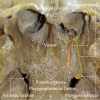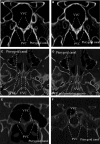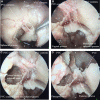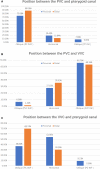Visualisation of the vomerovaginal canal during endonasal transpterygoid approaches and CT imaging diagnosis
- PMID: 31318052
- PMCID: PMC6637440
- DOI: 10.1111/joa.13009
Visualisation of the vomerovaginal canal during endonasal transpterygoid approaches and CT imaging diagnosis
Abstract
The vomerovaginal canal (VVC) and palatovaginal canal (PVC) are two canals that open forward to the posterior wall of the pterygopalatine fossa (PPF). Although the anatomy and computed tomography (CT) appearances of the PVC have been well studied, the VVC has been rarely reported, especially in endoscopic examinations. Some studies have even failed to distinguish the PVC from the VVC on CT images. The purpose of this study was to demonstrate the anatomy of the VVC on endoscopy and reveal its differences from the PVC, and to analyse the relative positions of the VVC, PVC, and pterygoid canal on CT images. Ten dry skull bases were studied to observe the structures involved in the formation of the VVC. Dissection of four cadaveric heads was performed to demonstrate the anatomy of the VVC on endoscopy. Coronal CT image analysis in 70 patients was conducted to evaluate the distances and relative positions between the VVC, PVC, and pterygoid canal. The PVC and VVC were also compared on axial CT images. The osteological study showed the top wall of the VVC was the antero-inferior wall of the sphenoid sinus. The VVC may be a helpful landmark in endoscopic endonasal transpterygoid approaches. Steps and discrimination in the dissections of the VVC and PVC were described. The interval between the PVC and VVC could be observed on both coronal and axial CT images. The coronal CT images of patients showed differences in the positions and distances among the three canals at both the anterior and posterior apertures of the PVC. The VVC can be easily mistaken for the PVC if its existence is not suspected. The anatomical morphologies and trajectories of the VVC and PVC differed on both nasal endoscopy and CT. The existence of the VVC should be considered during surgery and CT diagnosis within this area.
Keywords: endoscopy; palatovaginal canal; pterygopalatine fossa; transpterygoid approaches; vomerovaginal canal.
© 2019 Anatomical Society.
Conflict of interest statement
The authors declare that they have no conflict of interest.
Figures






References
-
- Chen J, Xu F, Xiao J (2009) Anatomy of palatovaginal canal in normal adults: multi‐slice spiral CT and curved planar reconstruction studies. Chin J Radiol 43, 4.
-
- Chen CC, Chen ZX, Yang XD, et al. (2010) Comparative research of the thin transverse sectional anatomy and the multislice spiral CT on pterygopalatine fossa. Turk Neurosurg 20, 151–158. - PubMed
-
- Cheng Y, Gao H, Song G, et al. (2016) Anatomical study of pterygoid canal (PC) and palatovaginal canal (PVC) in endoscopic trans‐sphenoidal approach. Surg Radiol Anat 38, 541–549. - PubMed
-
- Chong VF, Fan YF (1997) Pterygopalatine fossa and maxillary nerve infiltration in nasopharyngeal carcinoma. Head Neck 19, 121–125. - PubMed
Publication types
MeSH terms
Grants and funding
LinkOut - more resources
Full Text Sources

